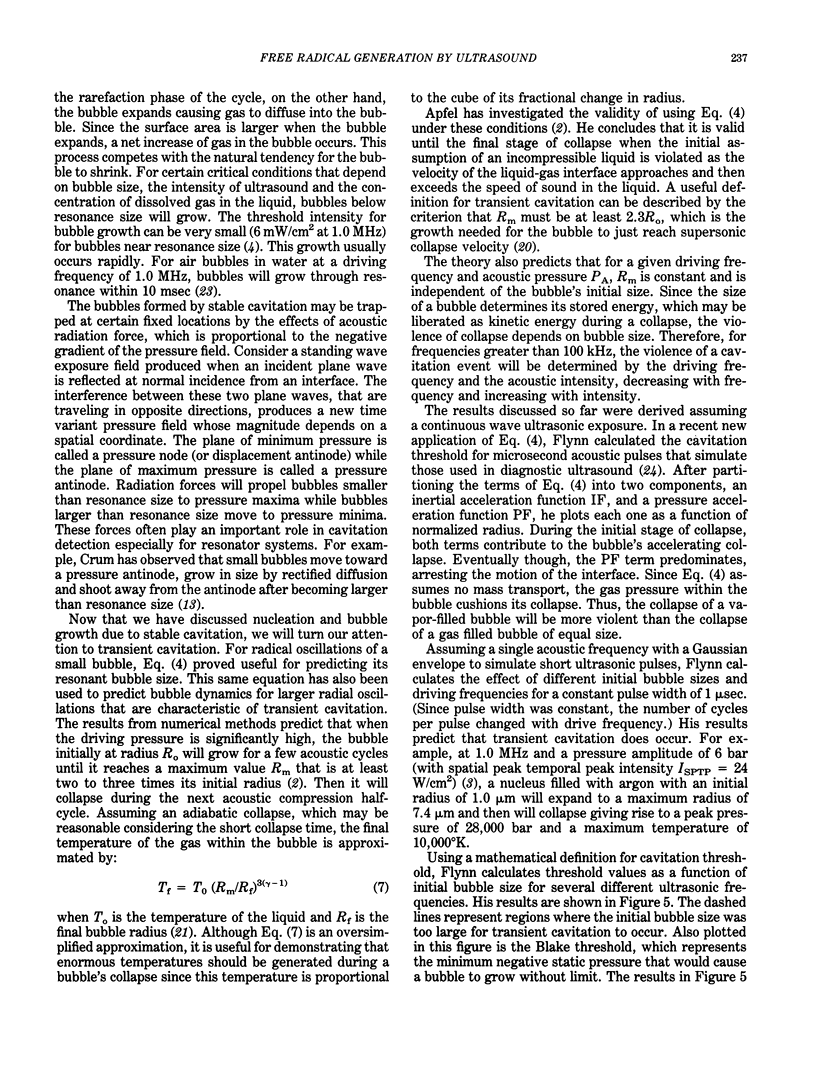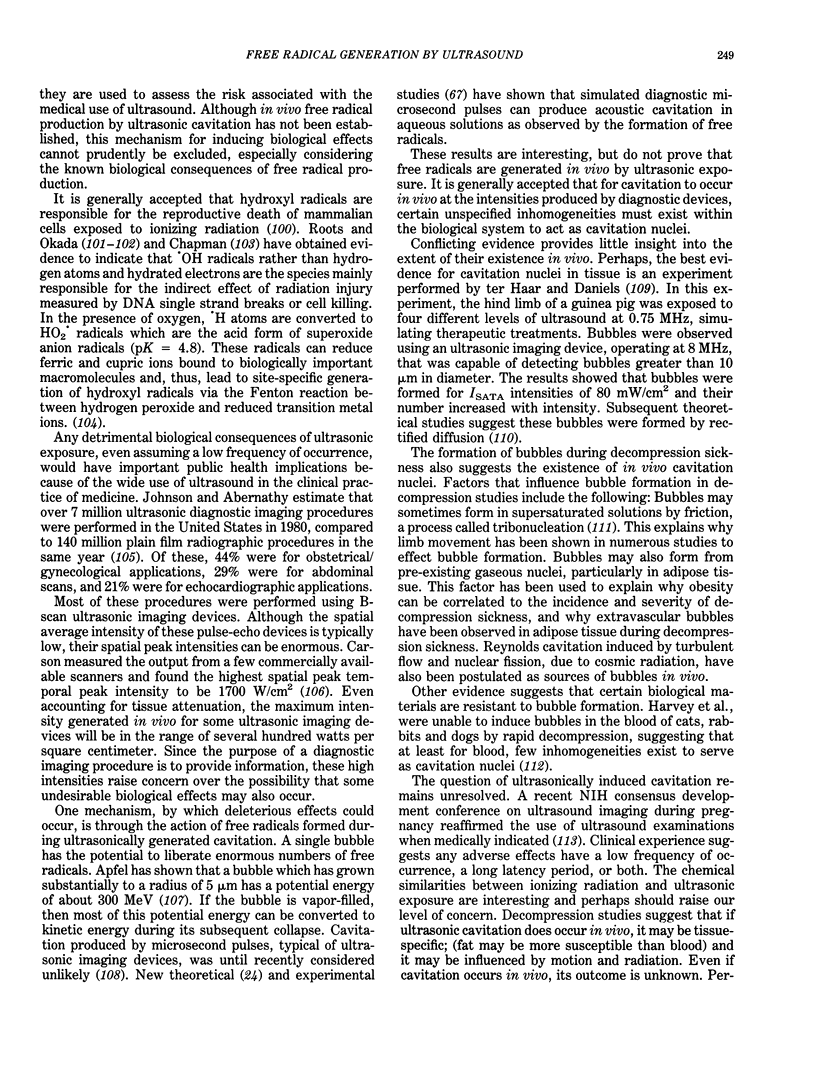Abstract
The physical principles underlying the oscillatory behavior of minute gas bubbles in liquids exposed to ultrasound are reviewed. Results from mathematical analyses suggest that these oscillations sometimes become unstable leading to transient cavitation in which a bubble violently collapses during a single acoustic half-cycle producing high temperatures and pressures. The role that micronuclei, resonant bubble size, and rectified diffusion play in the initiation of transient cavitation is explained. Evidence to support these theoretical predictions is presented with particular emphasis on sonoluminescence which provides some non-chemical evidence for the formation of free radicals. Acoustic methods for conducting sonochemical investigations are discussed. In aqueous solutions transient cavitation initially generates hydrogen atoms and hydroxyl radicals which may recombine to form hydrogen and hydrogen peroxide or may react with solutes in the gas phase, at the gas-liquid boundary or in the bulk of the solution. The analogies and differences between sonochemistry and ionizing radiation chemistry are explored. The use of spin trapping and electron spin resonance to identify hydrogen atoms and hydroxyl radicals conclusively and to detect transient cavitation produced by continuous wave and by pulsed ultrasound is described in detail. The study of the chemical effects of cavitation in organic liquids is a relatively unexplored area which has recently become the subject of renewed interest. Examples of the decomposition of solvent and solute, of ultrasonically initiated free-radical polymerization and polymer degradation are presented. Spin trapping has been used to identify radicals in organic liquids, in polymer degradation and in the decomposition of organometallic compounds.
Full text
PDF



















Selected References
These references are in PubMed. This may not be the complete list of references from this article.
- Apfel R. E. Acoustic cavitation: a possible consequence of biomedical uses of ultrasound. Br J Cancer Suppl. 1982 Mar;5:140–146. [PMC free article] [PubMed] [Google Scholar]
- Armour E. P., Corry P. M. Cytotoxic effects of ultrasound in vitro dependence on gas content, frequency, radical scavengers, and attachment. Radiat Res. 1982 Feb;89(2):369–380. [PubMed] [Google Scholar]
- Carmichael A. J., Makino K., Riesz P. Quantitative aspects of ESR and spin trapping of hydroxyl radicals and hydrogen atoms in gamma-irradiated aqueous solutions. Radiat Res. 1984 Nov;100(2):222–234. [PubMed] [Google Scholar]
- Carson P. L., Fischella P. R., Oughton T. V. Ultrasonic power and intensities produced by diagnostic ultrasound equipment. Ultrasound Med Biol. 1978;3(4):341–350. doi: 10.1016/0301-5629(78)90076-5. [DOI] [PubMed] [Google Scholar]
- Chapman J. D., Reuvers A. P., Borsa J., Greenstock C. L. Chemical radioprotection and radiosensitization of mammalian cells growing in vitro. Radiat Res. 1973 Nov;56(2):291–306. [PubMed] [Google Scholar]
- Church C. C., Flynn H. G., Miller M. W., Sacks P. G. The exposure vessel as a factor in ultrasonically-induced mammalian cell lysis--II. An explanation of the need to rotate exposure tubes. Ultrasound Med Biol. 1982;8(3):299–309. doi: 10.1016/0301-5629(82)90036-9. [DOI] [PubMed] [Google Scholar]
- Crum L. A., Hansen G. M. Growth of air bubbles in tissue by rectified diffusion. Phys Med Biol. 1982 Mar;27(3):413–417. doi: 10.1088/0031-9155/27/3/008. [DOI] [PubMed] [Google Scholar]
- Edmonds P. D., Sancier K. M. Evidence for free radical production by ultrasonic cavitation in biological media. Ultrasound Med Biol. 1983 Nov-Dec;9(6):635–639. doi: 10.1016/0301-5629(83)90009-1. [DOI] [PubMed] [Google Scholar]
- Finkelstein E., Rosen G. M., Rauckman E. J. Spin trapping of superoxide and hydroxyl radical: practical aspects. Arch Biochem Biophys. 1980 Mar;200(1):1–16. doi: 10.1016/0003-9861(80)90323-9. [DOI] [PubMed] [Google Scholar]
- Flynn H. G., Church C. C. A mechanism for the generation of cavitation maxima by pulsed ultrasound. J Acoust Soc Am. 1984 Aug;76(2):505–512. doi: 10.1121/1.391592. [DOI] [PubMed] [Google Scholar]
- Gold R. B. Ultrasound imaging during pregnancy. Fam Plann Perspect. 1984 Sep-Oct;16(5):240–243. [PubMed] [Google Scholar]
- Johnson J. L., Abernathy D. L. Diagnostic imaging procedure volume in the United States. Radiology. 1983 Mar;146(3):851–853. doi: 10.1148/radiology.146.3.6828707. [DOI] [PubMed] [Google Scholar]
- Makino K., Mossoba M. M., Riesz P. Formation of .OH and .H in aqueous solutions by ultrasound using clinical equipment. Radiat Res. 1983 Nov;96(2):416–421. [PubMed] [Google Scholar]
- McDonough P. M., Hemmingsen E. A. Bubble formation in crabs induced by limb motions after decompression. J Appl Physiol Respir Environ Exerc Physiol. 1984 Jul;57(1):117–122. doi: 10.1152/jappl.1984.57.1.117. [DOI] [PubMed] [Google Scholar]
- McKee J. R., Christman C. L., O'Brien W. D., Jr, Wang S. Y. Effects of ultrasound on nucleic acid bases. Biochemistry. 1977 Oct 18;16(21):4651–4654. doi: 10.1021/bi00640a019. [DOI] [PubMed] [Google Scholar]
- Roots R., Okada S. Estimation of life times and diffusion distances of radicals involved in x-ray-induced DNA strand breaks of killing of mammalian cells. Radiat Res. 1975 Nov;64(2):306–320. [PubMed] [Google Scholar]
- Roots R., Okada S. Protection of DNA molecules of cultured mammalian cells from radiation-induced single-strand scissions by various alcohols and SH compounds. Int J Radiat Biol Relat Stud Phys Chem Med. 1972 Apr;21(4):329–342. doi: 10.1080/09553007214550401. [DOI] [PubMed] [Google Scholar]
- Samuni A., Chevion M., Czapski G. Roles of copper and O(2) in the radiation-induced inactivation of T7 bacteriophage. Radiat Res. 1984 Sep;99(3):562–572. [PubMed] [Google Scholar]
- Weissler A., Pecht I., Anbar M. Ultrasound Chemical Effects on Pure Organic Liquids. Science. 1965 Dec 3;150(3701):1288–1289. doi: 10.1126/science.150.3701.1288. [DOI] [PubMed] [Google Scholar]
- ter Haar G. R., Daniels S. Evidence for ultrasonically induced cavitation in vivo. Phys Med Biol. 1981 Nov;26(6):1145–1149. doi: 10.1088/0031-9155/26/6/013. [DOI] [PubMed] [Google Scholar]


